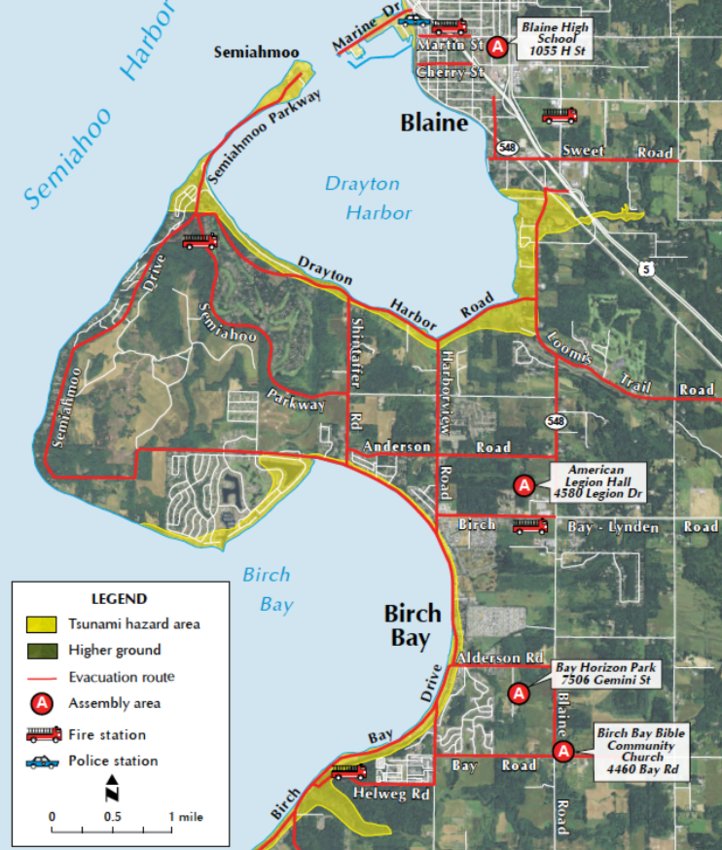By Taylor Nichols
Blaine and Birch Bay are among the dozens of Washington communities preparing for a tsunami using a $725,822 grant awarded to the state this year. The funding will go toward evacuation route signs, public education materials and three new tsunami sirens for the state, one of which was installed in Birch Bay last month.
To test emergency preparedness capabilities, communities throughout Washington will sound tsunami sirens at 10:18 a.m. on Thursday, October 18 as part of the Great Washington ShakeOut, an earthquake and emergency drill.
The grant comes from the National Oceanic and Atmospheric Administration (NOAA) and the National Weather Services (NWS) and is part of larger efforts to better prepare Washington for tsunamis.
United States senator Maria Cantwell (D) has been a proponent for this, sponsoring legislation in 2017 to strengthen NOAA’s tsunami programs.
“Senator Cantwell has been a great supporter of these funds,” said Keily Yemm, tsunami program coordinator for the state. “Without her help, without those NOAA grant funds we’d be at zero for the tsunami program.”
NOAA awarded nearly $6 million in grant funding this year split between 25 recipients nationwide, including the State of Washington Division of Emergency Management.
Other areas in the state will be adding new tsunami evacuation route signage thanks to the grant. Part of the funding will also be used to make animation maps and videos public, so people can better understand what a tsunami might look like, Yemm said. “A picture’s worth a thousand words but a video is even more powerful,” she said.
Many people had questions about tsunami preparedness after Washington was put on tsunami watch, the first level of tsunami advisory messages, last January following a 7.9 earthquake off the coast of Alaska.
The state has focused efforts on providing better support to all communities as a result, Yemm said.
Whatcom County’s deputy director of emergency management, John Gargett, said there’s been a focus on training citizens to be prepared in Blaine and Birch Bay through programs like the Community Emergency Response Team program, which provides basic emergency response training.
“I believe Whatcom County is better off and better prepared than most communities,” Gargett said.
It’s difficult to pinpoint the likelihood of a tsunami and the potential magnitude it could be because there are many variables involved, Gargett said. Talks about earthquakes and tsun
amis in the area often include “the big one” residents in the Pacific Northwest have been waiting for, an earthquake that could occur on the Cascadia Subduction Zone fault off the coast.
 Danger Zone Map. Courtesy Image.
Danger Zone Map. Courtesy Image.
While opinions differ, Yemm said the state tsunami program asserts there is a 10 to 15 percent chance the Cascadia Subduction Zone earthquake will happen within the next 50 years.
Carrie Garrison-Laney is the tsunami hazards specialist and Pacific Marine Environmental Laboratory (PMEL) liaison at Washington Sea Grant in Seattle. She said the Cascadia and the Seattle faults are capable of causing tsunamis, and they suspect others in the area are as well.
“Cascadia is going to affect most of the coastal areas in some way,” she said. “People just need to be ready for a tsunami.”
Residents can prepare in a number of ways.
Yemm recommends people know evacuation routes and practice them. “If you feel the ground shaking, that is your warning,” she said. “Don’t be waiting for text alerts on your phone or for the sirens to go off.”
Having an emergency bag ready with basic supplies is another important step people should take, she said.
In the event of an earthquake or tsunami, alerts will be broadcast through televisions, radios and sirens. Whatcom County will be able to send out wireless text alerts to cell phones next year, Gargett said. Residents can also get a NOAA weather radio, which is especially important if they live in an area where they can’t hear the sirens.
Residents can also prepare for emergencies by taking first aid classes and storing supplies like food, water and blankets in vehicles and at work.
“Statistically the people who are injured or die [in an emergency] are a small number, and the way that you can stay out of that is to be prepared or at least thinking about things,” Gargett said.
Knowing whether your home or work is in a tsunami danger zone and knowing what you’ll need can help you be ready. However, the best piece of advice may be the simplest.
“If you feel the ground shake – leave,” Gargett said.
Comments
No comments on this item Please log in to comment by clicking here